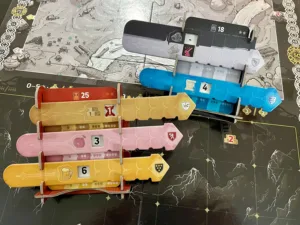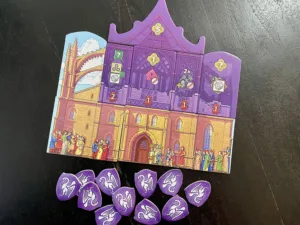 Renaissance Europe. Wealthy families. Contributing to growth and reaping the benefits. Economic trade and interactions with the church. We’ve seen all these ideas before. What we see less of are games that try to innovate the design space or provide deep historical context to provide ample thematic buy-in.
Renaissance Europe. Wealthy families. Contributing to growth and reaping the benefits. Economic trade and interactions with the church. We’ve seen all these ideas before. What we see less of are games that try to innovate the design space or provide deep historical context to provide ample thematic buy-in.
Kutná Hora: The City of Silver is designed by Ondřej Bystroň, Petr Čáslava, and Pavel Jarosch, and was provided by publisher CGE. It plays at two to four players with a play length from one to two hours. It’s also the first game to feature a new material for its components—re-wood—made from wood waste and recycled binding material. Is it just another Euro? Or is there something here that elevates it out of the grim darkness of the silver mines?
Gameplay Overview:
Kutná Hora is a round-based game where players take turns playing two cards from their hand of six cards. Each player has an identical hand of cards, and each card features two potential actions. Players take actions from five of their six cards over the course of a round before they can refresh their hand and their potential actions.
Before we cover each action type, it’s important to note that players begin the game as part of a set of three guilds (out of six total) that give them access to only a portion of the economic market. Setup cards for the guilds as well as the game’s mining board provide variability based on player count. For the guilds specifically, multiple players have access to similar guilds, setting up potential interaction along the way.

The game’s seven actions inform most of the remaining elements on the table. All actions correlate to an ever-shifting pricing market with resources that are tied to each guild. This market features two decks of cards placed into stands with sliders that showcase supply and demand. Cards are moved to the back of the deck when population or ore production increases, and sliders are shifted when buildings are built, and this causes potential value changes.
- Action 1: Mine – Players have a pool of miners on their personal board that can be sent to the mine board to increase ore production, gain access to economic growth, as well as compete for area majority end-game points.
- Action 2 through 4: Rights -> Plot -> Building – Players must secure the rights to a building from their guild as well as purchase a plot of land with separate actions. Once these two elements are in place, they can then spend money to add a building to the city board.
- Action 5: Income – Money requires production. As players mine and build, their production levels increase. Players use this action to gain income based on their production level.
- Action 6: St. Barbara – Next to the main board is the cathedral. Players contribute to this piece by piece, potentially unlocking powerful one-time bonuses.
- Action 7: Joker – The wild card action. This requires a reputation loss (on the player’s individual reputation track) but provides flexibility when needing to shift strategy.

Scoring is provided from several areas. There are end-of-round patrician scorings based on four scoring criteria that are used in each game. These are increased by the number of public buildings and active patricians purchased by players. For end-of-game scoring, the mining area majority provides a small amount of end game points, but the major scoring is provided by city buildings.
As players make the decision to gain building rights and claim plots of land, they must always be mindful of icons are that featured both on the building tiles and any adjacent building tiles. Players who match icons in an orthogonally adjacent manner score points. There are also public buildings that enter play that provide even more icons, but are not player controlled, making them popular locations for adjacent plots.

Game Experience:
There’s a new material in the market! Re-wood provides a new avenue to shift away from plastic and provide high quality components. Those included here feel excellent and provide high detail on the houses and miners. I’m all for ideas redefining the consumer waste created in arenas that mass produce. I do hope that more publishers seek out ways to improve the industry and adopt this material.
I enjoy quite a bit about Kutná Hora. The card action selection isn’t innovative, and doesn’t create too much tension, but it’s nice to create a moment of consideration for players who may take a chance on losing out on an action later in the round. The card art is excellent as well. The game is less about how the actions are situated on the cards though as it comes down to an order of operations puzzle based on building prices, claimed plots, and the shifting economy.

Speaking of economy, the supply/demand system is novel. It doesn’t feel as dynamic as it maybe could, especially at lower player counts (assisted though by event cards which can be added to any player count), but it’s still active enough to disrupt plans. Do you have just enough to buy a building, only to see lumber prices rise by the time your turn comes around? Did you even consider that was an option? That space is where the market truly shines, which is more dynamic in the beginning when income is much harder to gain.
Another highlight of this novel approach to a game economy is the fact that it shifts away from resource token tracking and makes it all about money. I absolutely applaud the idea of moving away from resource tokens and attempting more ideas such as this. Even a resource track is better than a bunch of little chits being gained or lost during play. Here it does mean that math comes into play when gaining money during the income action and can slow things down a bit. Thankfully, CGE has released a companion app that makes this less of a concern.

Another area that shines is the shared guild system. Giving players incentive in certain pieces of the economy is excellent and provides another way to highlight the economic centerpiece. Player actions can specifically affect everyone at the table in different ways, increasing pricing or making things inexpensive, based on how they interact with their guilds. There are nine total guild setup cards that provide variable options as well.
Beyond the production, Kutná Hora is fun to play. It may overstay its welcome at four players but having one less round of play does help. It has a well-considered interaction space, from plot and mine locations to action timing and patrician scoring. I always enjoy systems with scoring incentives. Here, players can dictate the power of end-of-round scoring by virtue of the public buildings they build. As such, everyone must be aware and ready to capitalize on the potential for each of the four scoring criteria.
I must highlight three areas that did not work well for me. The first and foremost is the St. Barbara Cathedral action. Not all the benefits on each piece of the cathedral are equal. As they are one-time bonuses for whoever gets there first, it can make this part of the game swingy. It also pulls focus from the true action of the game and adds more to the table. I wish this had been excised from the design to boost another area.

With that said, there is an ever-increasing tax penalty at the end of each round. Tax is increased in several ways, but the tax cost can be completely negated for a small reputation loss. The reputation track already feels a little tacked on, and with this tax negation it can feel unfair to those who’ve taken the time to build income to pay. I almost wish that this area was more dynamic and punishing, and rather than the St. Barbara action, there was a different action in place to interact with reputation and/or taxes.
The final note I’ll add is that while there are plenty of setup cards for both the guild options and mining, it does feel like there is variety missing. Almost like an expansion is needed to really boost replayability. The event cards are great and provide historical context (as does the excellent rulebook), but there need to be a lot more of them. More buildings and mine tiles would also be nice.
Final Thoughts:
If an expansion to this game shows up that replaces the cathedral action, adds more variety, and finds a way to make events and the tax track more interesting, this would be a mainstay in my collection. If they found a way to create an even more dynamic economy or potentially variety in that realm, this may enter top-tier euro status.
As it stands right now, Kutná Hora is a fun and unique experience that tries something new while still finding a connection to the euro design space. Not all elements worked for me, making it feel like it was one more draft away from having staying power. I trust that if this product does well for CGE, we’ll see new options to enhance the design further. Recommended for those who want to shake up a market and get their hands dirty in the mines.
Final Score: 3.5 stars – Unearths exciting new ideas that need some silver polish to shine.
 Hits:
Hits:
• Dynamic economy
• Re-wood components
• Guild loadouts
• Historical context and rulebook
Misses:
• Cathedral action
• Lack of variety
• Tax track punishment





















